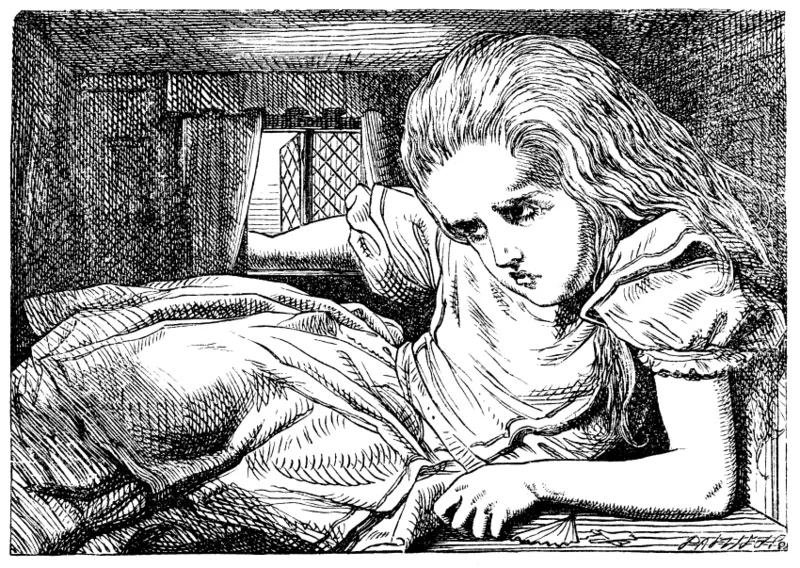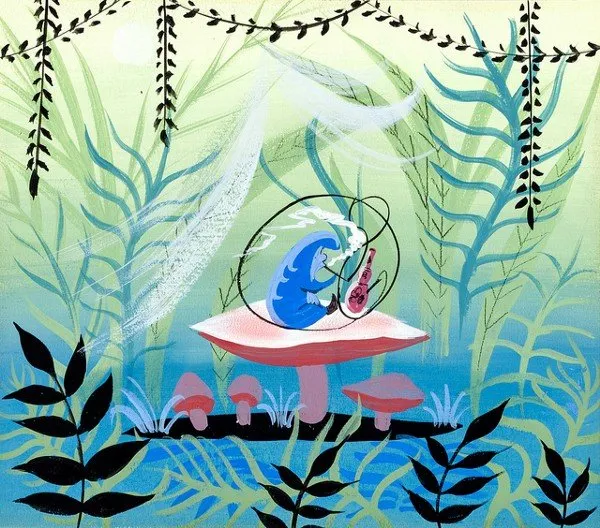 Alice in Wonderland (Wikipedia)
Alice in Wonderland (Wikipedia)Have you ever been sleepy and trying to concentrate on something, perhaps reading a book in bed as you begin to drift off to sleep, when things suddenly started to get a little strange? Have parts of your body grown to enormous proportions, or have objects in the room suddenly appeared to be impossibly far away? If so you may be one of the small number of people who have experienced Alice in Wonderland Syndrome.
Curiouser and Curiouser
Alice in Wonderland Syndrome (AIWS) is a neurological condition that alters the perception of space, time and body image. People experiencing AIWS will commonly report the feeling that parts of their body have altered in shape and size, particularly the head and hands. This range of experiences, known as ‘dysmetropsia’, can be broken down into four categories. Micropsia is the sensation that objects are smaller than they actually are, whilst Macropsia is where objects feel larger. Likewise Pelopsia is where objects appear nearer than they really are, whilst Teleopsia is (you guessed it!) when they feel much farther away. AIWS sufferers report these symptoms in various combinations, creating their own unique brew of perceptual distortions. For some, their lack of spatial perspective is accompanied by a loss of their sense of time — with time (and their own movements) either feeling like it is being fast-forwarded, or passing incredibly slowly, akin to during a psychedelic experience.
The following case studies from psychiatrist Dr John Todd in 1955 provides an interesting insight into the condition:
“She complained of recurrent attacks during which she feels that her body is growing larger and larger until it seems to occupy the whole room. “I feel,” she said, “that I have got so big that if I put out my hand I could touch the far wall.’ Less frequently, she feels that she is getting smaller, “shrinking up completely”, and that her hands will “drop off and disappear.”
“These consisted in a recurrent feeling that he was much taller or shorter than was actually the case. Sometimes he felt that he was eight feet tall, but at other times he felt as though he had shrunk to a mere three feet. In addition, he was often conscious of a feeling that his head was “twice its normal size and as light as a feather” or that one or other of his arms was missing.”
Although AIWS is associated with certain neurological diseases, it is typically a temporary condition that many people will experience during childhood, which naturally wears off over time. Whilst it can be debilitating for some sufferers, particularly if episodes occur frequently and unpredictably, this appears to be relatively rare. However, most frequently it is reported at the onset of sleep, with many people only ever reporting it when they are particularly tired. Evidence suggests that AIWS may actually much more common than we realise.
Lewis Carroll and Migraines
AIWS is often associated with migraines, with some hypothesising that it is simply a form of migraine aura. In 1955, psychiatrist Dr John Todd discovered that several of his AIWS patients experienced severe migraine headaches or had migraine in their family history. Todd speculated that as Lewis Carroll was famously known as a migraine sufferer who experienced visual disturbances, he may have used his own experiences as inspiration for Alice’s journeys in Wonderland. Whilst there is no direct evidence to confirm this, there are some indications in Alice in Wonderland that do appear to support the theory. For example, in one section of the book Alice is blinded by moonlight — a possible reference to the light sensitivity of the migraineur — and of course the famous scene with the caterpillar and the mushroom in which Alice becomes larger and smaller:

“In a minute or two the Caterpillar took the hookah out of its mouth and yawned once or twice, and shook itself. Then it got down off the mushroom, and crawled away in the grass, merely remarking as it went, ‘One side will make you grow taller, and the other side will make you grow shorter.’ ‘One side of what? The other side of what?’ thought Alice to herself. ‘Of the mushroom,’ said the Caterpillar, just as if she had asked it aloud; and in another moment it was out of sight.”
Although this is a tempting theory, it has to be noted that there are also plenty of things that happen in Alice in Wonderland that bear no resemblance to Carroll’s life. I’m guessing he never fell down a rabbit hole, played croquet with a flamingo or saw a baby turn into a pig, so why should we assume that Alice’s size alterations are anything more than a fantastical tale? I often wonder whether people tend to overanalyse the “strangeness” of Wonderland, particularly when they incorrectly attribute its creation to Carroll’s supposed experimentation with LSD — which was first synthesized almost 75 years after Alice in Wonderland was published!
What’s happening in the brain?
Although surprisingly little research has been carried out on AIWS, there is one reported case in which a 12 year old girl was scanned in an fMRI machine during an episode. In her case, episodes were triggered by concentrating hard on a printed page, so in order to replicate this, neurologist Dr. Sheena Aurora used a black-and-white checkerboard pattern to mimic the black-and-white printed page. This technique was successful, and once inside the machine it was evident that there was a burst of electrical activity and increased blood flow in the areas of the brain responsible for vision, texture, size and shape, particularly the parietal lobe, which processes our perceptions of the environment.
My Experiences
This syndrome is of particular interest to me, as I experience a mild form of AIWS from time to time. Since childhood it has been an ordinary part of being sleepy, and growing up I reasoned that as I got increasingly tired these perceptual alterations were simply an indication that my brain was beginning to shut down, as I drifted towards sleep. I never found them alarming, only ever intriguing, and I would do my best to extend them as much as I could to have fun with them! I assumed that this was something everyone experienced until it came up in conversation when I was much older. I also suffer from migraines and didn’t learn of the connection until relatively recently, although for me they do not appear to be predictive or occur concurrently.
Reading when I am tired is a pretty consistent trigger, and on the whole it’s just a matter of time before it will occur. Although it feels like a mental trick of perspective, for me it’s definitely not purely related to visual perception, as the feeling persists whether my eyes are open or closed. It’s more related to how my body feels. During these episodes, everything feels huge (both my own body and my surroundings) but it’s impossible to tell whether things are very close or very far away — it is almost both simultaneously! My body feels like that of a concrete giant, as if I am made of stone; heavy and slow. One moment I’ll be laying right beside my other half in the dark having an ordinary conversation, my hand just inches away from hers, and then the next moment it feels at once as if myself and the entire contents have become enormous and are crowding the room, but that even if I stretched out my arm fully it would be impossible to reach her hand. I can shake off this feeling by walking around and waking up a little, but most often I just enjoy the feeling as a curiosity — almost like a free psychedelic trip. I can understand how terrifying and disorienting this must be when it occurs so frequently or uncontrollably, but in this mild form I enjoy it as an insight into a different mode of consciousness.
Have you experienced anything similar? I’d be really curious to learn if this is more widespread than previously thought and about the different ways it might manifest, so please share your experiences below!
(This post is my own original content. All references and image sources are linked to within the text.)
Thanks for reading
I will continue to publish similar content in the upcoming weeks, so be sure to follow if you'd like more posts about philosophy, cosmology and consciousness. This post was also published on Medium, and any future content I create will be posted on both platforms. If you want to follow me elsewhere you can find me at:
Twitter - @ongoingwow
Medium - @ongoingwow
Instagram - @ongoingwow